What to Do If Your Persian Cat Has Eye Problems
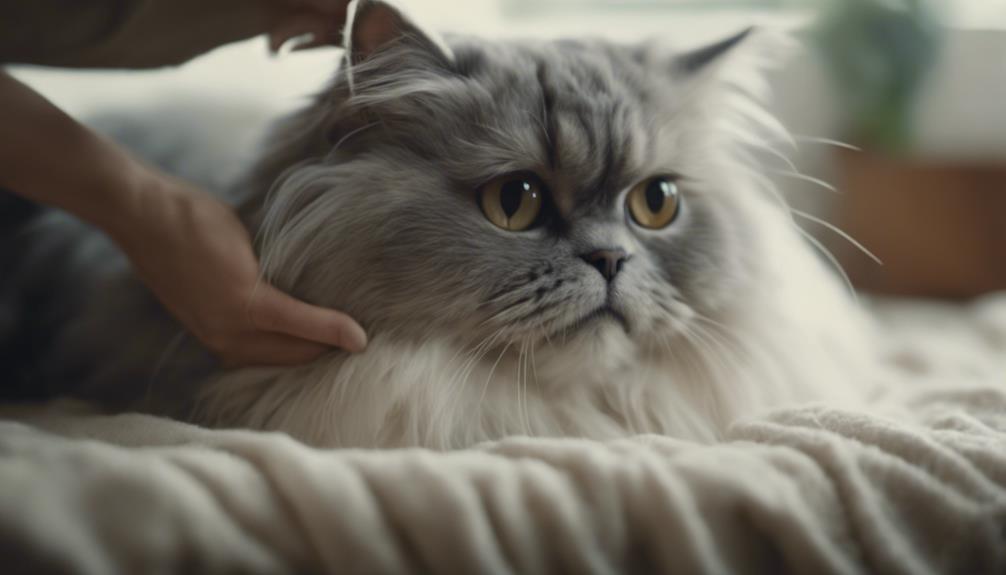
Persian cats are known for their beautiful and expressive eyes, but they are also prone to certain eye problems. It is important for Persian cat owners to be aware of these issues and know how to handle them effectively.
- Regular Eye Exams: Schedule regular check-ups with your vet to monitor your Persian cat's eye health. Early detection of any problems is key to successful treatment.
- Keep Eyes Clean: Persian cats have long fur around their eyes, which can lead to tear staining and debris buildup. Gently clean their eyes with a damp cloth to prevent infections.
- Watch for Symptoms: Keep an eye out for symptoms of common eye problems in Persian cats, such as excessive tearing, redness, squinting, or cloudiness. If you notice any of these signs, consult your vet immediately.
- Avoid Harsh Chemicals: When cleaning your cat's eyes, avoid using harsh chemicals or products that could irritate their sensitive eyes. Opt for gentle, vet-approved solutions instead.
- Provide a Balanced Diet: A nutritious diet plays a crucial role in maintaining your cat's overall health, including their eye health. Make sure your Persian cat is getting all the essential nutrients they need.
- Protect from Injuries: Persian cats are known for their playful nature, but rough play can lead to eye injuries. Keep an eye on your cat during playtime and provide a safe environment to prevent accidents.
Remember, the key to handling Persian cat eye problems is early detection and prompt treatment. By following these essential tips and steps, you can help keep your Persian cat's eyes healthy and vibrant.
Common Persian Cat Eye Problems
Common Persian cat eye problems often stem from their unique skull structure, making them prone to conditions like corneal ulcers, entropion, and other feline eye issues. Due to their brachycephalic skull shape, Persian cats may suffer from exophthalmos, a condition where their eyes protrude, increasing the risk of developing corneal ulcers. Additionally, ankyloblepharon and entropion, which involve eyelid abnormalities such as fusion or inward turning, are common in this breed.
Corneal ulcers can be particularly problematic for Persian cats, as their eyes are more exposed and vulnerable to injuries. Entropion, a condition where the eyelids roll inward, can cause irritation and discomfort. These issues can lead to excessive tearing, known as epiphora, and subsequent skin problems and infections if left untreated.
Regular veterinary check-ups are crucial for early detection and management of these eye problems. Proactive grooming and prompt intervention can help maintain the eye health of Persian cats and prevent more severe complications like blindness from primary glaucoma.
Understanding Persian Cat Eye Discharge
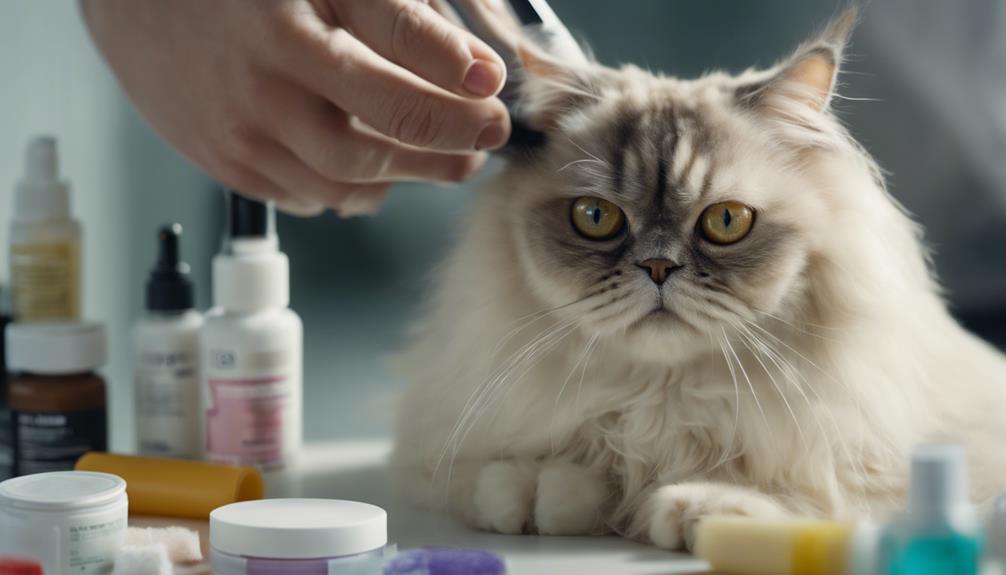
Persian cat eye discharge can stem from various causes such as conjunctivitis or allergies. Symptoms may manifest as watery eyes, cloudiness, or increased tear production.
Treatment options include medications like antibiotics or surgical interventions based on the underlying issue.
Causes of Discharge
Eye discharge in Persian cats can stem from various underlying causes, such as conjunctivitis, upper respiratory infections, corneal disorders, allergies, and uveitis. These conditions can lead to different types of eye discharge and require specific treatment approaches.
The causes of eye discharge in Persian cats include:
- Conjunctivitis: Inflammation of the conjunctiva, leading to discharge.
- Upper respiratory infections: Viral or bacterial infections affecting the eyes.
- Corneal disorders: Damage or abnormalities in the cornea causing excessive tearing.
- Allergies: Hypersensitivity reactions resulting in eye irritation and discharge.
- Uveitis: Inflammation of the uvea, causing eye redness and discharge.
Understanding these potential causes is crucial for effectively addressing eye discharge in Persian cats.
Treatment Options
When addressing eye discharge in Persian cats, understanding the specific treatment options tailored to the underlying cause is essential for effective management. Treatment for eye discharge in Persian cats may involve medications such as antibiotics, decongestants, steroid or antibiotic ointments, eye drops, and in some cases, surgical interventions.
Differentiating between the specific cause of eye discharge is crucial to determine the most appropriate treatment for Persian cats. Veterinary consultation is essential if eye discharge persists for more than 24 hours in Persian cats to prevent potential complications.
Providing prompt attention to eye discharge in Persian cats can help avoid discomfort, infections, and vision problems. Proper treatment tailored to the individual cat's condition is vital for a successful resolution of Persian cat eye problems.
Prevention Tips
Maintaining consistent eye hygiene practices is crucial to mitigate the risk of eye discharge issues in Persian cats. Here are some preventive measures to help keep your Persian cat's eyes healthy:
- Clean your cat's eyes regularly to remove any buildup or debris.
- Use a damp cloth or specialized eye wipes recommended by your veterinarian.
- Keep the fur around the eyes trimmed to prevent irritation and blockage of tear ducts.
- Ensure your cat's diet is balanced and provides essential nutrients for eye health.
- Regularly consult your veterinarian for guidance on preventive care routines tailored to your Persian cat's specific needs.
Preventing Persian Cat Eye Infections
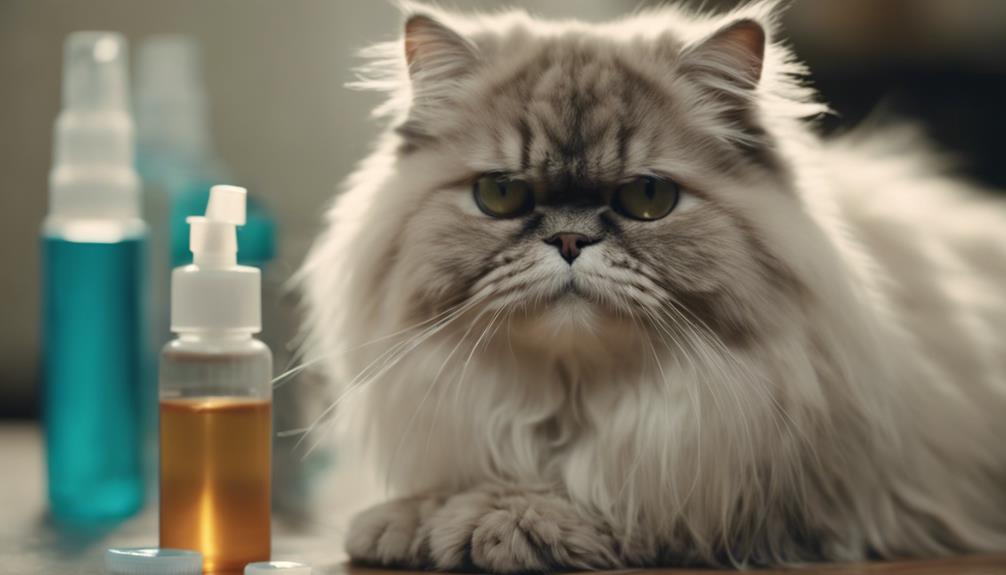
Regularly cleaning a Persian cat's eyes is crucial to prevent dirt buildup and minimize the risk of eye infections.
Using vet-approved eye cleaning solutions and techniques can help maintain optimal eye health in these cats.
Monitoring for signs of eye discomfort, redness, or excessive tearing is essential to catch any potential infections early.
Eye Hygiene Tips
To maintain optimal eye hygiene and prevent infections in Persian cats, daily cleaning with warm water and lint-free cotton pads is recommended. Here are some essential eye hygiene tips for preventing Persian cat eye infections:
- Gently wipe away any cat eye discharge or debris using a moistened lint-free cotton pad.
- Use tear stain removers specifically formulated for cats to help prevent staining and irritation.
- Apply protective powders around the eyes to absorb excess moisture and prevent skin irritation.
- Monitor your Persian cat's eyes regularly for any signs of redness, swelling, or cloudiness.
- Seek prompt veterinary attention if you notice persistent eye discharge or any concerning changes in your cat's eye health.
Common Infection Causes
Proper grooming practices and a clean living environment play crucial roles in preventing eye infections in Persian cats, which can be caused by bacteria, viruses, allergies, and environmental irritants. Regularly cleaning your Persian cat's eyes and keeping their living area free of dust and potential irritants can help reduce the risk of eye infections.
It's important to watch out for symptoms like redness, swelling, discharge, or discomfort in your cat's eyes, as these could indicate an infection. If you notice any of these signs, seek prompt veterinary attention to prevent complications. Avoid using any over-the-counter eye drops or medications without consulting a vet, as they may worsen the condition.
Early detection and proper treatment are essential to maintain your Persian cat's eye health.
Vet Check Importance
Veterinary check-ups play a crucial role in preventing and detecting eye infections in Persian cats. Regular veterinary check-ups are essential for maintaining the eye health of Persian cats. Here are five key reasons why vet check-ups are important for preventing eye infections:
- Routine eye examinations can help identify early signs of eye problems.
- Veterinarians provide guidance on proper eye care practices to minimize infection risks.
- Early intervention by a vet can prevent minor issues from escalating.
- Veterinary consultations address concerns or symptoms related to eye problems promptly.
- Regular check-ups help detect any potential eye infections early, leading to better treatment outcomes.
Cleaning Your Persian Cat's Eyes
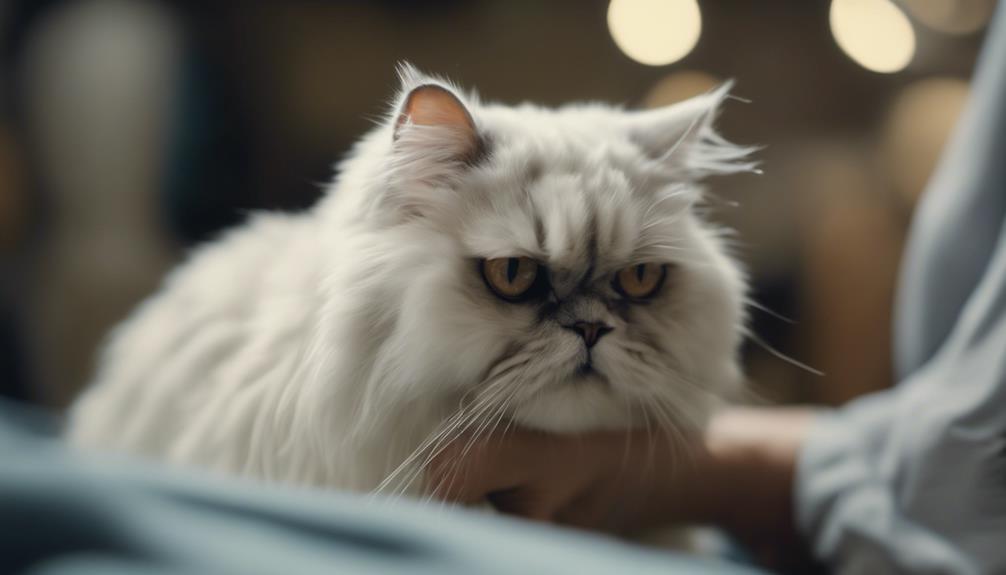
When cleaning your Persian cat's eyes, ensure to use lukewarm water and lint-free cotton pads for gentle care.
Regular eye cleaning is essential for Persian cats as it helps prevent dirt buildup and reduces the risk of eye infections. To clean your cat's eyes, dampen a lint-free cotton pad with lukewarm water and gently wipe the area around the eyes. Be patient and gentle to avoid causing any discomfort to your feline friend.
While cleaning, watch out for signs of infection such as redness, swelling, or unusual discharge. Consistent eye care routines play a crucial role in maintaining your Persian cat's eye health and can help prevent staining issues.
Surgical Options for Eye Problems
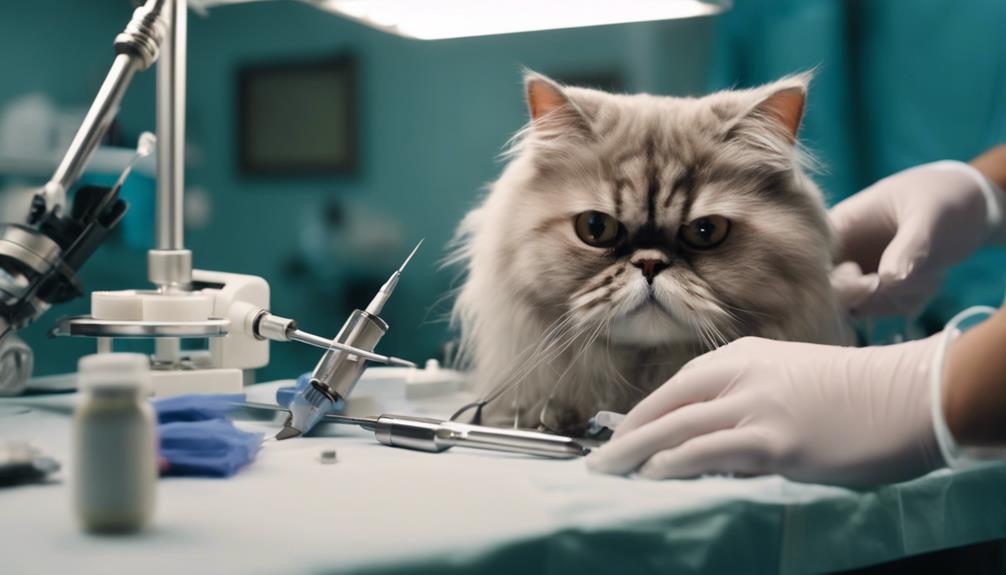
To address complex eye issues in Persian cats, surgical options may be necessary, including procedures tailored to conditions like Epiphora, Exophthalmos, and Entropion. Consulting a veterinary ophthalmologist is crucial to determine the most suitable surgical treatment for your cat's specific eye problem.
Here are some key points to consider regarding surgical options for Persian cat eye problems:
- Specialized Procedures: Surgical interventions may involve specialized procedures targeted at correcting conditions such as Epiphora, Exophthalmos, and Entropion.
- Expert Consultation: Seeking advice from a veterinary ophthalmologist is essential to assess the severity of the issue and recommend the most effective surgical treatment.
- Precision Surgery: Surgical treatment aims to correct abnormalities, restore proper eye function, and alleviate discomfort or potential vision impairment in Persian cats.
- Post-Operative Care: Adequate post-operative care is vital for the successful recovery of Persian cats undergoing eye surgery.
- Follow-Up Visits: Regular follow-up visits with the veterinarian are necessary to monitor the healing process and ensure optimal outcomes following surgical interventions for Persian cat eye problems.
Treatment for Eye Discharge in Persians
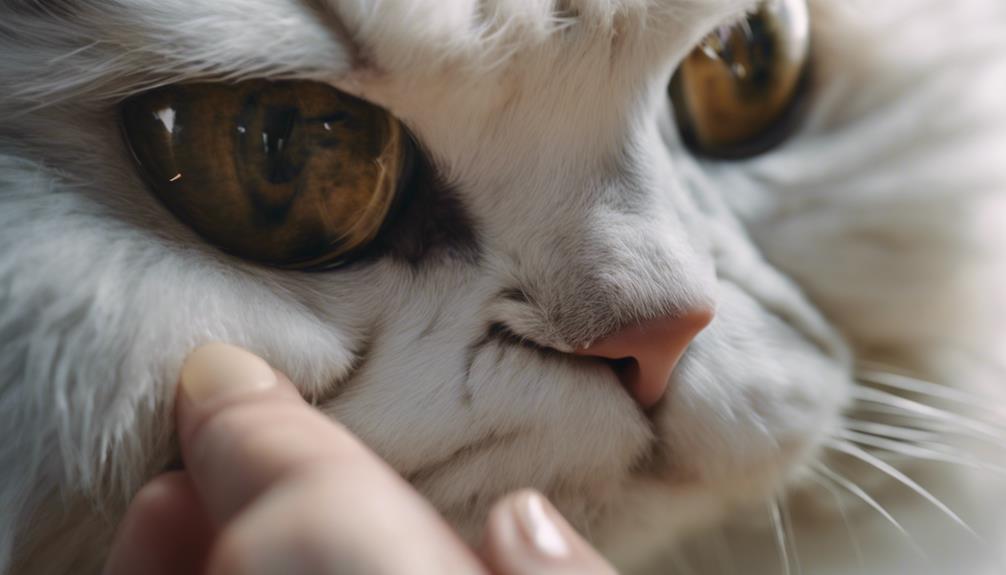
Eye discharge in Persian cats can have various underlying factors such as conjunctivitis, upper respiratory infections, corneal disorders, allergies, or uveitis. Tailored treatment approaches are necessary for effective management. When dealing with eye discharge, addressing the root cause is essential.
For conjunctivitis, antibiotic or steroid ointments prescribed by a veterinarian can help. Corneal disorders may require the use of eye drops, antibiotic ointments, or in severe cases, surgical intervention. Managing eye discharge associated with upper respiratory infections often involves fluids, decongestants, and antibiotics to clear the infection.
Allergies leading to discharge may call for specific allergy medications. Uveitis, characterized by eye inflammation, may require specialized ointments and drops to reduce swelling and discomfort. It's crucial to follow the vet's guidance closely and administer medications as directed to ensure the best outcome for your precious Persian feline.
When to Seek Veterinary Care
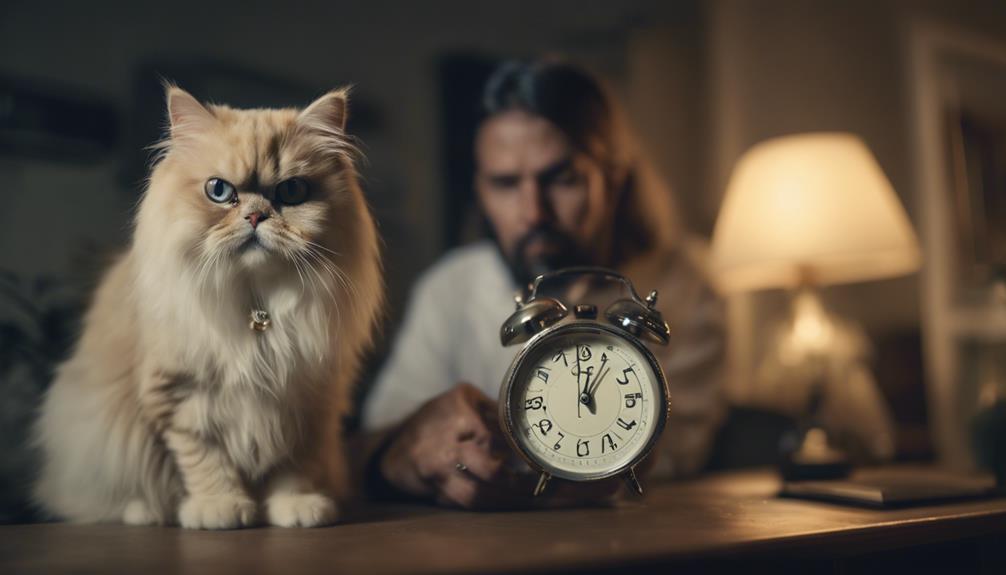
At the first sign of excessive tearing, redness, or discharge in your Persian cat's eyes, prompt veterinary care is crucial to address any potential eye problems effectively. Seeking veterinary advice early can help prevent complications and ensure the best outcome for your feline friend.
Here are five key indicators that should prompt you to seek veterinary care for your Persian cat's eye issues:
- Persistent squinting or closing of the eye
- Pawing at the eye or rubbing it against objects
- Any changes in the appearance of the eye, such as cloudiness or swelling
- Unusual sensitivity to light or avoiding bright environments
- Noticeable changes in your cat's behavior, such as increased irritability or lethargy
Frequently Asked Questions
How Do You Treat Persian Cats Eyes?
Regular veterinary check-ups for Persian cat eye care are crucial. Eye cleaning routines with vet-approved products help prevent issues. Proper nutrition containing Taurine and Vitamin A is essential. Breeding and genetics impact eye health. Environmental factors require prevention measures.
Why Do Persian Cats Have Eye Problems?
Persian cats have eye problems due to genetics, predisposing them to conditions like Epiphora and Exophthalmos. Environmental factors and hygiene play a role, exacerbating issues. Breeding standards also contribute, emphasizing the need for careful breeding practices to mitigate these concerns.
How Do You Treat Eye Problems in Cats?
When treating eye problems in cats, home remedies like warm compresses can provide comfort. However, veterinary care is crucial for accurate diagnosis and treatment. Preventive measures include regular check-ups, maintaining good hygiene, and promptly addressing any signs of discomfort in your feline friend.
How Do I Know if My Persian Cat Has an Eye Infection?
To determine if a Persian cat has an eye infection, look for signs such as eye discharge, redness, or squinting. These symptoms may indicate an issue that requires veterinary attention for proper diagnosis and treatment.










